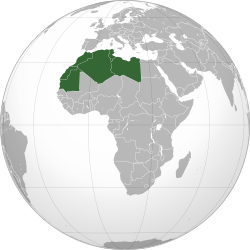- See Mizrahi Jews for more information about the Eastern Jews.

Due to proximity, the terms Maghrebi Jews (Moroccan Jews, Algerian Jews, Tunisian Jews, and Libyan Jews) are frequently used in reference to Egyptian Jews as well.
Maghrebi Jews (מַגּרֶבִּים or מַאגרֶבִּים, Maghrebim) or North African Jews (יהודי צפון אפריקה Yehudei Tzfon Africa) are ethnic Jews who had traditionally lived in the Maghreb region of North Africa (al-Maghrib, Arabic for "the west") under Arab rule during the Middle Ages.[1] Established Jewish communities had existed in North Africa long before the arrival of Sephardi Jews, expelled from Portugal and Spain. The term Musta'arabi was also used by medieval Jewish authors to refer to Jews who had traditionally lived in the Maghreb.[2] Due to proximity, the term 'Maghrebi Jews' (Moroccan Jews, Algerian Jews, Tunisian Jews, and Libyan Jews) sometimes refers to Egyptian Jews as well, even though there are important cultural differences between the history of Egyptian and Maghrebi Jews.[1] These Jews originating from North Africa constitute the second largest Jewish diaspora group.[3]

Maghrebi Jews lived in multiple communities in North Africa for over 2,000 years,[3] with the oldest Jewish communities present during Roman times and possibly as early as within Punic colonies of the Ancient Carthage period. Maghrebi Jews largely mixed with the newly arrived Sephardic Jews, beginning from the 13th century until the 16th century, eventually being overwhelmed by Sephardim and embracing the Sephardic Jewish identity in most cases.
The mixed Maghrebi-Sephardic Jewish communities collapsed in the mid-20th century as part of the Jewish exodus from Arab countries, moving mostly to Israel, France, Canada and Venezuela. Today, descendants of Maghrebi-Sephardic Jews in Israel have largely embraced the modern Israeli Jewish identity and in many cases intermix with Ashkenazi and Mizrahi Jewish communities there. Most of the Maghrebi-Sephardic Jews (Western Jews) also consider themselves as part of Mizrahi Jewish community (Eastern, or Babylonian Jews), even though there is no direct link between the two communities. They have similar histories of Arabic-speaking background and a parallel exodus and expulsion from Arab and Muslim countries: the Mizrahim left nations of the Middle East, and the Maghrebi-Sephardics left nations of North Africa in the mid-20th century. Among Arab countries, the largest Jewish community now exists in Morocco with about 2,000 Jews and in Tunisia about 1,000.[4]
- ^ a b "The Jews of Algeria, Morocco and Tunisia". Retrieved 9 May 2020.
- ^ Landman, Isaak (2009). Volume 2, The Universal Jewish Encyclopedia. Varda Books. p. 81.
- ^ a b Campbell, C. L.; Palamara, P. F.; Dubrovsky, M.; Botigue, L. R.; Fellous, M.; Atzmon, G.; Oddoux, C.; Pearlman, A.; Hao, L. (6 August 2012). "North African Jewish and non-Jewish populations form distinctive, orthogonal clusters". Proceedings of the National Academy of Sciences. 109 (34): 13865–13870. Bibcode:2012PNAS..10913865C. doi:10.1073/pnas.1204840109. ISSN 0027-8424. PMC 3427049. PMID 22869716.
- ^ Rosenberg, Jerry M. (28 September 2009). The Rebirth of the Middle East. Hamilton Books. ISBN 978-0-7618-4846-2.
